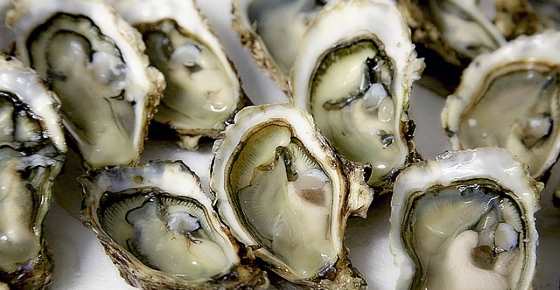Oysters are widely appreciated worldwide as a delicacy of the sea. Although they are not categorized under a single name, oysters come in various textures, flavors, and sizes, each with its own unique taste. Different species of oysters are named according to the seas where they are harvested. The Pacific, Japanese, and Atlantic Eastern oysters are the most common types of oysters, belonging to the superfamily Ostreoidea and classified as true oysters under the phylum Mollusca.
These shellfish are typically found in shallow water in marine or brackish environments and have flat, irregularly shaped shells that cover their edible insides. Raw or cooked oysters are the most popular ways to consume them. Fresh raw oysters only require a squeeze of lemon juice and a sprinkle of cayenne pepper to be enjoyed. Oysters have an important role in maintaining marine ecosystems, as they filter up to 50 gallons (190 liters) of water daily, serving as water filters and improving the nutrient levels in oceans and seas.
This article discusses the various types of oysters available for consumption, highlighting the best and tastiest types of raw oysters.
Types of Oysters With Their Picture and Name
While some individuals may find it unappetizing to eat raw seafood, many others across the globe do so. Let’s take a look at some of the most common oyster types.
Pacific Oysters (Crassostrea Gigas)

Pacific oysters, also referred to as Japanese or Miyagi oysters, are a type of large oyster commonly grown and farmed on the Pacific coasts of Japan and the US. The scientific name for these oysters is “gigas,” which means large, and they typically grow on rocks or mud-sand bottoms in cool ocean waters at depths of 16 to 130 feet (5 to 40 meters). Due to their species, these oysters can reach an average size of 3″ to 6″ (8 to 15 cm) and sometimes grow up to 12 inches (30 cm) in size. They have a hard, pale-colored shell that feels rough and firm, reaching maturity after two to four years.
Pacific oysters have been exported to other countries, but they are native to Japan, where they are cultivated on the Pacific coastlines. They are also common in the seas surrounding the UK, New Zealand, and Australia, making them one of the most prevalent types of oysters worldwide.
When it comes to taste, Pacific oyster flesh is silky and velvety, with a sweet flavor that has creamy overtones and a hint of earthiness. They are less salty than Atlantic or Eastern oysters, making them a popular choice among oyster lovers.
Atlantic Oysters (Crassostrea virginica)

Atlantic oysters have a variety of names, including the American oyster, Wellfleets, Blue points, Eastern oyster, and Totten Inlet Virginica. The Chesapeake Bay in Maryland was the first place where this species of oyster was discovered. Eastern (Atlantic) oysters thrive in saltwater temperatures ranging from 60 to 60°F (15.5 to 20°C) and are named after the Chesapeake Bay.
Similar to Pacific oysters, Atlantic oysters range in size from 3 to 7 inches (8 to 18 cm) and have white or gray/brown shells speckled with purple streaks that give them a hard calcium appearance. Their white meat has a purple or red-brown edge and is covered by the shell. They are most commonly found in shallow coastal seas and estuaries.
Despite originating on the Eastern Coast, these large oysters also grow on the coasts of Northern Europe. However, the sweetest oysters are said to come from the Pacific, not the Atlantic. Atlantic oysters have a unique salty flavor with a strong marine essence, and some describe them as having a creamy flavor with notes of seaweed and mushrooms. Due to their cold-water nature, the oyster flesh is slightly crisp.
The flavor of Atlantic oysters can also vary depending on where they are harvested, and many of the species’ popular names refer to regions in the United States. For instance, Blue points oysters are from Long Island and Wellfleets, both from Cape Cod, Massachusetts. Meanwhile, Kumiai oysters, a type of Pacific oyster, come from Vizcaino Bay, Baja California.
Kumamoto Oysters (Crassostrea sikamea)

Kumamoto oysters are a small variety of Japanese oysters that can be found off the coasts of Australia and other Western Pacific countries. These tasty little oysters have unevenly shaped hard shells and are closely related to Pacific oysters. In comparison to Pacific oysters, which grow to an average of 4 inches (11 cm), Kumamoto oysters are only about 2 inches (5 cm) in size, and some Kumamoto species are even smaller.
The firm oyster meat is protected by a deep fluted shell, which can have a white-green color. The flesh has a thick, velvety texture and a subtle salty flavor, appearing ivory-white in color. To differentiate them from Pacific oysters, this species of oyster is referred to as “Kumamotos.”
Kumamoto oysters have a unique fruity taste and a bowl-shaped shell that oyster enthusiasts find appealing. They are an excellent option if you want a sweet-tasting oyster. Due to their small size and delightful flavor, Kumamoto oysters are often the first choice for novice oyster eaters.
European Flats (Ostrea edulis)
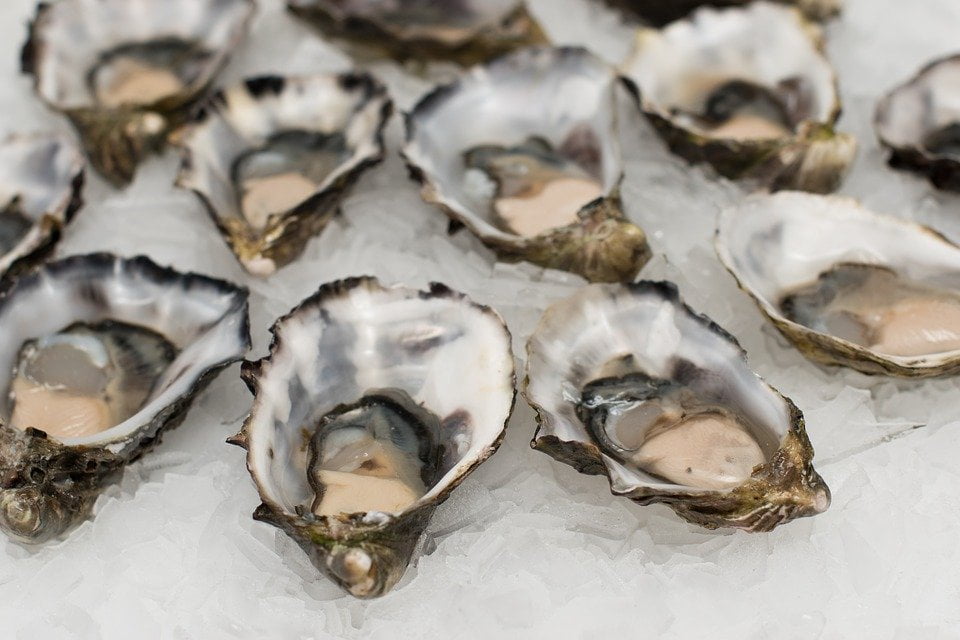
European flat oysters are named for their flat pear or oval-shaped shells that cover the muscle meat and are farmed in many coastal areas. Belon oysters, mud oysters, and Colchester native oysters are some of the popular names of saltwater mollusks that belong to Europe. Unlike Pacific and Atlantic oysters, this species has a salty flavor with copper or metallic overtones. Their shallow, ridged shells are another way to distinguish this species from other oyster species.
European oysters are a valuable farmed species in many coastal economies and take around two to three years to mature. The hard shells are yellowish or cream-colored and range in size from 1.5″ to 4″ (4 – 10 cm) in diameter. The oyster meat comes in various hues, from pale gray to creamy white, and the shells are pearly-white on the inside. If European oysters are marketed as “Belon Oysters,” they must come from the Belon River in France. Although some producers label their oysters “Maine Belon Oysters,” they are not genuine ‘Belons.’
The texture of European oyster meat is tender to firm, and it has a strong metallic, coppery flavor that makes a statement. European oysters have a less salty flavor and a residual sweetness compared to “Pacifics” or “Atlantics.” Their firm texture makes them ideal for making fish soups, stews, and baked stuffed oysters.
Olympia Oysters (Ostrea lurida / conchaphila)
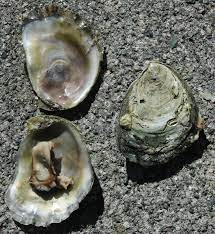
Olympia oysters have a distinctive, strong flavor and are a small oyster species. The common names of this oyster may also indicate where it is harvested. For example, Olympia oysters are also known as California oysters and come from Washington. Native oysters or Rock oysters are two other names for this oyster species. However, there is some ambiguity regarding whether they are Ostrea lurida or Ostrea conchaphila since they look and taste so similar. Olympia West Coast oysters from British Columbia are farmed mainly in Puget Sound and are a popular delicacy.
The Olympia oyster has a unique oval shape that is sometimes almost round, which is one of the primary identifying characteristics. In contrast, huge Pacific oysters have a pear or tear-shaped appearance. Similar to European Belons, this oyster species has a shallow shell, with a shell color ranging from light purple to black, with a greyish tinge.
Olympia oysters are a favorite among many oyster enthusiasts. The oyster flesh has a creamy texture and ranges in color from light olive green to ivory white. It has a salty punch with metallic mineral undertones, which is rare. In fact, they are often referred to as “baby Belons” because of their flavor, which is comparable to European oysters.
Sydney Rock Oysters (Saccostrea glomerate)
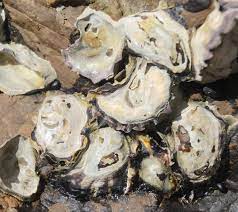
Sydney rock oysters are a popular oyster species in Australia and New Zealand, also known as New Zealand rock oysters or Auckland oysters. These hard-shelled mollusks inhabit shallow waters, protected bays, and estuaries.
Sydney rock oysters are known for their smooth shells, unlike some of their Northern Hemisphere oyster counterparts, which have rough, irregular shells. These oysters range in size from 2 to 3 inches (5 to 8 cm) in length.
The flesh of Sydney rock oysters is light white or yellowish in color and can be seen by cutting open the shells. Compared to other popular oysters, they have a milder, sweeter flavor with less brininess than Pacific oysters. However, they lack the richer, sharper mineral flavor of other oyster species.
Dredge Oysters (Ostrea chilensis)
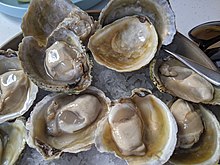
The dredge oyster is a genuine oyster species found in New Zealand, also known as the Chilean oyster due to its origin in Chile. In New Zealand, the Ostrea chilensis is commonly referred to as the Bluff oyster and is one of the country’s most famous shellfish.
These oysters are harvested from the Foveaux Strait in the South Island region, near the town of Bluff, which inspired their name. The oyster shells are rounder in shape and have a dull purple-brown color, with a flatter, ridged shell compared to the bowl-shaped shell of other oyster species.
When shucked using an oyster knife, the dredge oyster reveals creamy-colored flesh with streaks of gray. These oysters typically range in size from 2.3 to 3.1 inches (6 to 8 cm) in length, with meaty sweetness, notes of seaweed, and mild saltiness that characterize the delicate and creamy oyster flesh.
Shigoku Oysters

The Shigoku oysters are a Pacific oyster species that were introduced in 2009 and come from Washington State. They are shaped like a mussel and are found in Willapa Bay and Samish Bay. These oysters have tough and salty flesh, with a delicious and briny flavor that many people enjoy.
On average, Shigoku oysters grow to be 3 inches (7.6 cm) in size. The name “Shigoku” means “ultimate” in Japanese, which speaks to the high regard in which these oysters are held due to their great taste and numerous fans.
Other Types of Oysters
Some of the world’s most popular mollusks include Pacific oysters, Atlantic oysters, and European flat oysters. There are several other types of oysters to try depending on the location of the world.
Beausoleil Oysters
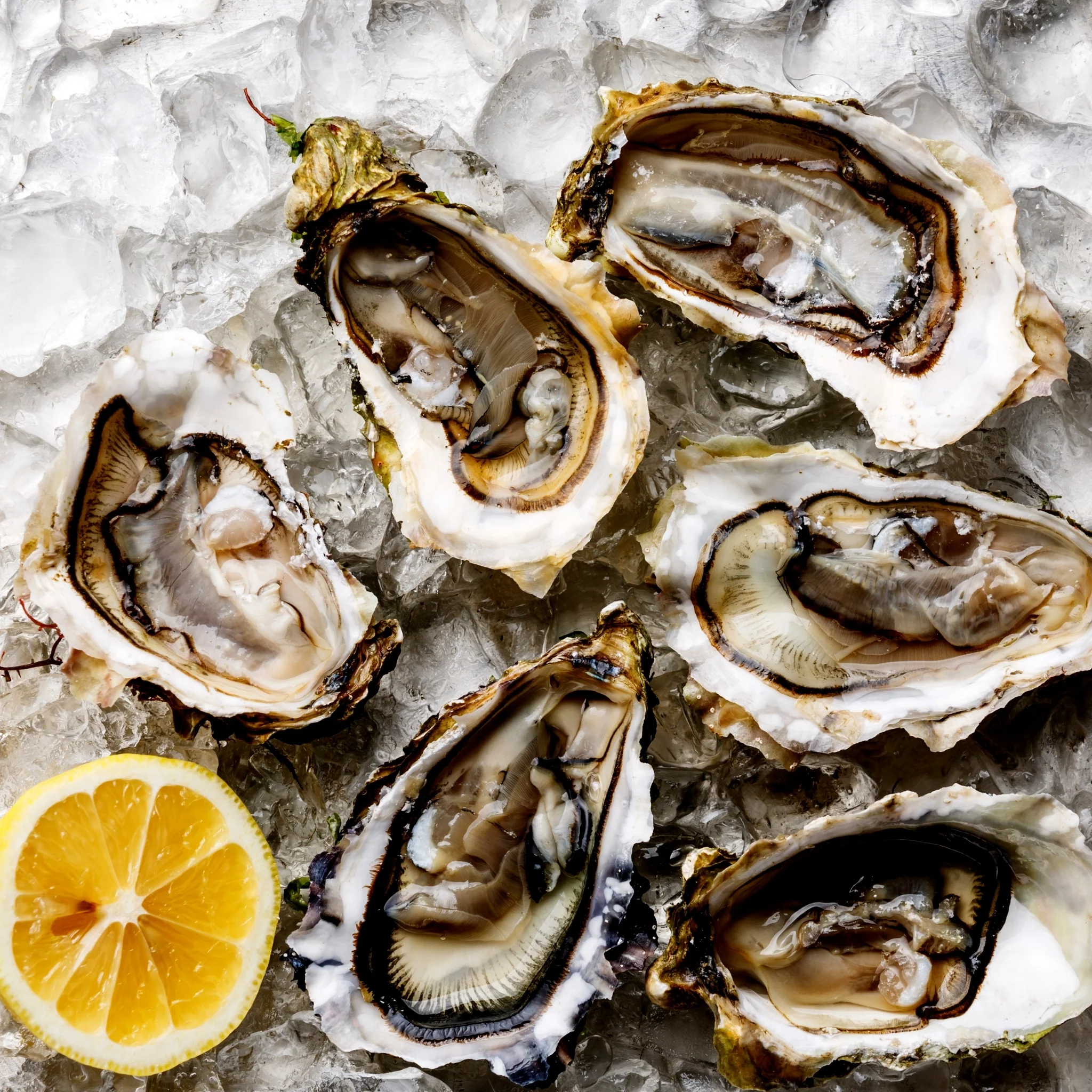
Beausoleil oysters are a type of Atlantic oyster that grows in the frigid waters of New Brunswick, Canada. They typically reach a length of about 2.5 inches (6.3 cm) in four years, making them a small variety of Atlantic oyster (Crassostrea virginica). The shells of these Atlantic oysters are a pale beige and gray color, while the meat is delectable.
Each bite offers a delightful flavor with nutty undertones and a hint of the sea. Many oyster experts recommend trying Beausoleil oysters as a first foray into the world of oysters.
Misty Point Oysters
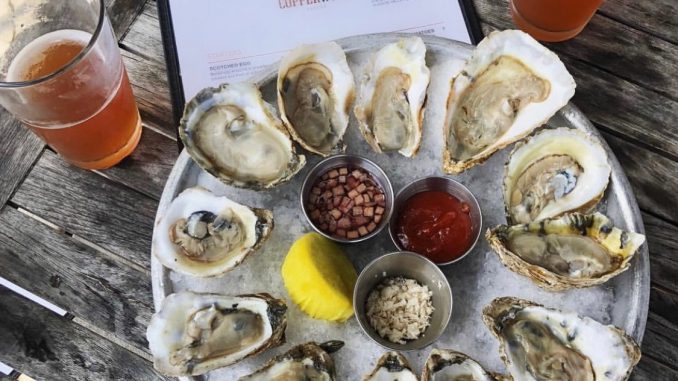
Roasted misty point oysters are a popular kind of Atlantic oyster, as seen in the photograph. They’re shaped like an elongated oval and have a tough shell. They grow up to 3″ (7.6 cm) and come from the Virginia Barrier Islands. What do Misty Point oysters taste like? The sea has a salty, earthy flavor that stands out. The flesh is creamy and solid, with a pleasant consistency.
Wellfleet Oysters
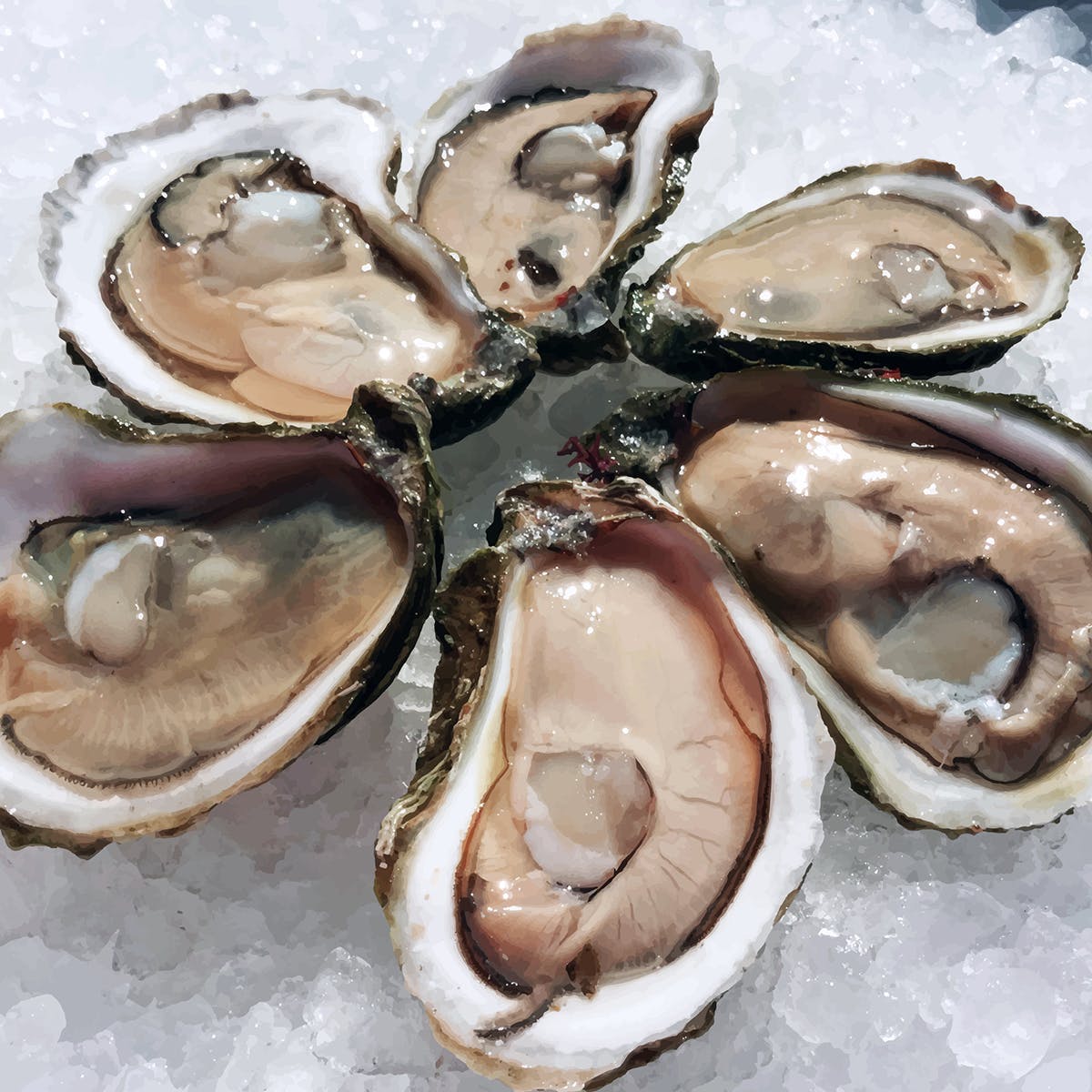
Wellfleet oysters are a popular type of oyster that is grown in the estuaries of Wellfleet, Massachusetts. The waters in this region of the Atlantic Ocean provide an ideal environment for producing high-quality oysters. The cold waters help the oyster develop a strong, fibrous, and meaty muscle scar, which gives the oyster its distinctively sweet taste compared to other oyster species.
Furthermore, the high salinity and large tides create a salty and robust type of oyster that has a long shelf life.
Fine de Claire

One of the greatest oysters you can try in Europe is the Fine de Claire oyster variety. This is a top European oyster that has a elongated form and belongs to the hard-shelled mollusks. The fact that they are finished in salt ponds explains why they are of such high quality. This distinguishes the excellent salty oysters from various other oyster species.
How to Buy the Perfect Oyster
When it comes to consuming oysters, selecting the highest quality oysters is essential, particularly when eating them raw. Here are some tips to help you select the freshest, juiciest, and most delicious oysters:
- Supplier: Rather than buying oysters from a supermarket, it is best to purchase them directly from a reputable seafood supplier or fish market to ensure their freshness.
- Check the smell: Oysters should not have a strong or unpleasant odor, so make sure to give them a sniff. A reliable seller will allow you to open up an oyster to check for any unpleasant odor. If there is any such smell, avoid eating it.
- Avoid buying from tanks: Fresh oysters that have been kept on ice are preferable to those stored in water tanks. When oysters are kept in tanks, their brine is washed out, depriving them of their natural flavor. Opting for fresh oysters on ice ensures that you will enjoy the natural brine and the full range of flavors from the sea when you crack open the oyster.
